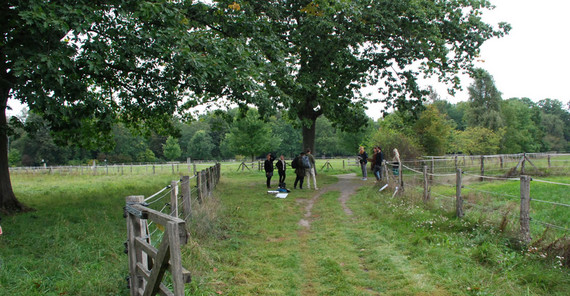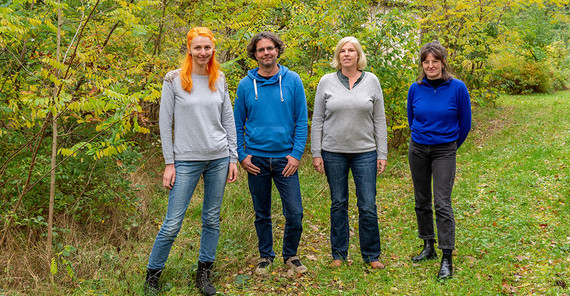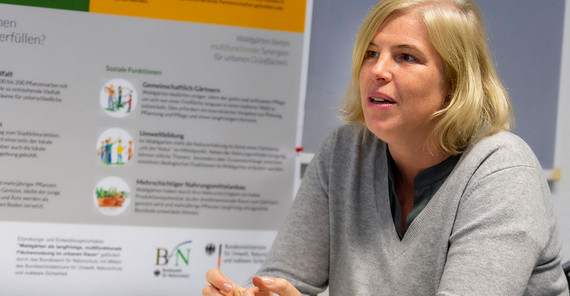The crowns of fruit trees – such as plum, apricot, and apple trees – form the canopy and protect bushes layer of berries such as currant, gooseberry, or raspberry underneath. Beneath them, there is an herbaceous layer of mostly perennial vegetables and herbs. “A forest garden is striving for the ecosystem structure of a mixed forest,” Schulz explains. “It mimics the overlapping layers of vegetation but with edible plants.” For the researcher, forest gardens represent the future of urban gardening creating synergies with biodiversity and climate protection. They make it possible, for example, to cultivate a large variety of crop plants on a relatively small space due to an arrangement in multiple layers. Ideally, the plants complement each other in terms of light, nutrient, and water requirements through different root architecture and depths and plant heights as well as individual light requirements. Based on a careful site-adapted selection and combination of species and varieties, the forest garden can provide yields almost all year round.
“At the same time, we urgently need the ecological function of the forest, especially in cities with lots of construction,” Schulz emphasizes. “A few green roof terraces are not enough.” The forest garden ecosystem functions as a CO2 reservoir, forms a cooling counterpart to overheated concrete deserts and supports the preservation of biodiversity. In the multi-layered biotope, numerous animal species and especially insects find a home – the useful insects among them in turn keep pests away and are essential for pollination.
Forest gardens are not only ecologically multifunctional, but they also offer perspectives for social encounter. “In cities, the few green spaces have to fulfill many functions – not least as social spaces,” Schulz explains one of the most important goals of the project. “Forest gardens should be places where people have the long-term perspective of gardening together, growing food, but also creating climate oases and establishing places where they can experience environmental education and intergenerational dialogue.”
Model garden in Britz
In Berlin-Britz, all these things will turn into reality in the coming years: the edible forest, the oasis, the educational place, and the meeting point for multiple generations. Many things have to work together for a forest garden to be grown. This was shown by the feasibility study conducted from 2018 to 2020 by the team led by Jennifer Schulz and Torsten Lipp from the University of Potsdam. First, the researchers evaluated whether there were any suitable areas at all in a major city like Berlin. "We developed a transparent procedure for systematic site search and evaluation,” says Schulz. Are the areas large enough? Uncultivated? Easily accessible? Where would forest gardens contribute to climate protection, green infrastructure, and environmental education? By using a specifically developed GIS model, existing information on urban areas can be analyzed, and potential sites can be evaluated. “For a forest garden, you should plan at least 5,000 m2 of space – and it must be available and available for contracting in the long term,” says the researcher. “This is a real challenge in Berlin, which is constantly changing and where building density tends to increase.” But it is equally important to determine whether there are people in the neighborhood who are interested in developing, building, and permanently managing the forest garden. Likewise, it is crucial to find out if there are institutions such as public administrations willing to support the project? For this, they had many discussions – with the Berlin Senate administration, district offices in charge of parks, allotment gardens associations, nature conservation organizations, and those active in urban gardening. “I’ve never experienced a project with so much momentum and euphoria,” Schulz says happily.
First planning, then planting
In the nearly 300-page final report of the feasibility study, the research team has compiled everything that needs to be considered when planning forest gardens. From finding the right area and the necessary activists to the equally important legal aspects that need to be considered. The right operating model, liability and safety issues – it takes more than a large meadow and a handful of plants to turn the idea into reality. “So far, the concept of a forest garden is unknown in urban planning. A lot of research, networking and communication with stakeholders, but also ingenuity and perseverance are needed here,” she says.
It took an intensive site search until the team found about a dozen potentially suitable sites, including public green spaces, green spaces adjacent to sports fields, educational institutions or housing estates, brownfield sites, and even a former cemetery. But one after the other had to be excluded. Most of them lacked the long-term perspective that is needed for a forest garden. In Berlin-Britz, things finally worked out. Instead of classic garden plots, an exemplary site will be created in the coming months and years south of Britzer Garten to bring people and plants together. “The site has been designated as a replacement area for allotment gardens that had been eliminated due to a highway construction. Apart of suitable soil and site characteristics the area comes along with an existing long term zoning plan as an allotment garden,” Schulz says. “As a result, the area is permanently protected. A precious situation.” For the new allotment area, the Potsdam researchers and their project partners, including the district association of allotment gardeners (Bezirksverband Berlin-Süden der Kleingärtner e.V.), the responsible administration, and volunteers who are enthusiastic about the project, have developed a novel, modern form of an allotment garden park with the forest garden as its guiding principle. Most recently, the 2.8-hectare area was used as grassland by Britzer Garten and was grazed with cattle. Beginning in 2022, 60 garden plots and a 5,000 m2 community forest garden will be created there. The community forest garden will be located in the center of the overall site, together with a 1,000 m2 zone for environmental education which will be supervised by the environmental education association Freilandlabor Britz e.V. Concerning the allotment gardens, eight to ten garden plots – some with and some without summerhouses – are grouped together in clusters, which will be jointly enclosed by a fence. No garden fences are planned within the clusters, which will have a common “core zone” that can be used and designed collectively, with fruit trees and shrubs following the forest garden structure.
Ideas of many people for a joint garden
This concept is the result of intensive preparatory work, which not only included the expertise of the researchers, landscape architects, and horticultural experts, but also the ideas and commitment of the involved citizens. Already in the summer of 2019, a series of workshops was held for this purpose – in a stimulating participation process accompanied by experts. “One important finding of our feasibility study is that this participatory process is essential for such a long-term and complex project as a forest garden,” Schulz explains. People have to get to know each other, exchange wishes and ideas, work together, and organize themselves. “The co design is the crucial process and foundation for the participants to ultimately take responsibility for the project and support it in the long term. You shouldn’t underestimate that. It might be a bumpy ride sometimes but things will get back on track.”
One of those involved in Britz is Philipp Resch. The 27-year-old is studying biotechnology at Technische Universität Berlin and has been involved since 2020. “I’ve always wanted to get a garden plot, but it wasn’t until the first lockdown that I finally had the time to take the initiative.” When he came across the project online, he was immediately convinced about it – “because it’s not a typical garden plot but a forest garden where each plant helps the others flourish, whether by providing shade or nutrients.” He finds the community of those who are actively involved particularly appealing. “A lot of knowledge is gathered which contributes to the project to varying degrees.”
Jennifer Schulz has also been involved in the garden design. Already during her studies, the researcher had come across the concept of forest gardens and studied the ecological benefits of this method of cultivation. Later, she created a forest garden with over 500 edible plants for a client. The forest garden in Britz is a personal highlight for her. “So far, forest gardens –- both in urban and rural areas – are still largely unknown and hardly researched in Germany. We can change both with our project.”
Fertile soil
Cooperating with various municipal institutions is essential for success, especially in Berlin, where it was necessary to convince two levels of administration at the same time, the district and the Senate administration. “The support of politics and administration is indispensable,” Schulz says. The district administration of Berlin-Neukölln leases the area to the Bezirksverband Berlin-Süden der Kleingärtner e.V., which bears great responsibility for the success of the project and will lease the plots to future users. The Berlin Senate Department for the Environment, Urban Mobility, Consumer Protection and Climate Action in turn contributes to the financing of the project. “As a result of the Corona pandemic, it was not clear whether we would be able to continue,” she explains. While Schulz wrote the necessary funding applications, her colleague Luisa Gedon continued working with the activists – due to the pandemic mainly online. The group communication is getting increasingly better thanks to the communication working group that Philipp Resch founded with two others. “Since we have started using the Miro website for online seminars and to prepare our ideas, our work has improved enormously,” he reports. “This has made it easier for us to submit our spatial planning results to the landscape architecture firm in the end.”
In spring 2021, the good news came out: A forest garden in the middle of Berlin is not only possible, but it will also become reality. Thanks to funding from the Federal Agency for Nature Conservation (BfN) and the Federal Ministry for the Environment (BMU) in the Federal Program on Biological Diversity and the Berlin Senate Department for the Environment, Urban Mobility, Consumer Protection and Climate Action, the project can be implemented over the next six years. All preliminary work on the spatial planning was handed over to a team of specialist planners led by a landscape architecture firm. Together with the volunteer group, they then worked out the final plans in participatory workshops. Two more forest gardens are being created simultaneously in Kassel. The city has been involved since 2019, and the local Department for Environment and Gardens is committed to promoting the project development there. In the meantime, important project structures and necessary staff positions have been created in both cities.
The researchers at the University of Potsdam will continue to coordinate the joint project, but will also provide scientific support and evaluation. Their goal is not only to create documentation for research purposes. A knowledge platform is also being created to ensure that the three project forest gardens are only the first of many. “With the help of the platform, we want to pass on all that we’ve learned in the project to enable other cities to go through this process themselves.” To that end, Schulz and the forest garden team have been collecting as much data as possible since the beginning. Even before construction began, two climate measuring stations were set up, one in the area of the forest garden, and a comparative one outside. They measure temperature, precipitation, humidity in the air and in the soil, solar radiation, and wind. Later, a number of small mini-transmitters, so-called data loggers, will be added at different locations in the area. And in line with the project’s spirit, the forest gardeners will also help: with species monitoring, for example. “In terms of soil biology, initial surveys have already been conducted on earthworms,” says Schulz. “Part of our team has been involved with this and is currently planning how to also incorporate civic engagement into forest garden research.”
Not just setting it up but also accompanying it
Digitization in the right places should also help, for example by using apps for monitoring species. Environmental education will be digitally supported from the beginning on as well. “We want to prepare the knowledge about forest gardens in such a way that it can also be experienced with the help of new media,” Schulz explains. “Our gardener is already compiling plant fact sheets. When these can be accessed via QR codes next to the plants, the knowledge will be available digitally on site – for gardeners and interested people alike.” However, the researchers not only accompany the planning, horticultural, or biological developments. The social dimensions are recorded as well. How do people in the project work together? How do they communicate? What is the knowledge gain and how is it used? The findings could be helpful for future projects.
Schulz is convinced that the model will form a precedent. After all, interest in the project was high from the very beginning. Even during the feasibility study, numerous cities and initiatives indicated their wish to participate, among them Bremen, Heidelberg, Freiburg, and Tübingen. The team has already looked for suitable sites with some of them. But the Corona pandemic has slowed down many of these initiatives. If the Britz and Kassel gardens bear fruit, they could gain momentum again. “I can really imagine that there will be a movement toward ecological urban redevelopment, in which forest gardens can play an interesting role,” Schulz says.
In Britz, things will really get started in spring 2022: The last fences and paths of the previous use were dismantled at the end of 2021. Over the course of 2022, the garden structure will be built and water connections laid for horticultural use. Then the new “residents” will also arrive: 400 (fruit) trees, 2,000 (berry) bushes, and 10,000 perennials of various kinds of vegetables and herbs will be planted. Numerous activities are planned together with the active participants: hands-on construction of garden sheds and seating areas, and planting. Resch is ready and full of anticipation. “To be honest, I don’t have that much experience in gardening yet. But what better way to learn than directly from other people?” He is certain: “Something great will be created on this site.”
The Project
Title: “Urban Forest Gardens: Perennial, Multi-Dimensional, Multi-Functional”
Funding: German Federal Office for Nature Conservation with funds from the German Federal Ministry for the Environment, Nature Conservation, and Nuclear Safety within the Federal Biological Diversity Program, Berlin Senate Department for the Environment, Urban Mobility, Consumer Protection and Climate Action.
Duration: April 2021 – March 2027
Project coordination: University of Potsdam: Dr. Jennifer Schulz and Dr. Torsten Lipp (both principal investigators), Luisa Gedon, Lea Matscheroth, Luca Durstewitz; project partners: Bezirksverband Berlin-Süden der Kleingärtner e.V., Freilandlabor Britz e.V., City of Kassel: Department for the Environment and Gardens
As part of the preliminary investigation of a BfN-funded testing and development project, the conditions for forest gardens in urban areas, including participation procedures, were investigated between 2018 and 2020. Based on the results, an in-depth participatory planning process and preparations were carried out for the project area in Berlin-Britz during 2021, so that the structure of the forest garden plots can be built in spring 2022 and the forest garden can begin to grow on this site. In Kassel, two forest gardens are to be created in parallel at the green belt of Wahlebach in Waldau and in the Marbachshöhe area.
The Team
Dr. Jennifer Schulz, Luisa Gedon, Dr. Torsten Lipp, , Luca Durstewitz and Lea Matscheroth
E-Mail: jennifer.schulzuuni-potsdampde
This text was published in the university magazine Portal Wissen - Eins 2022 „Zusammen“.



